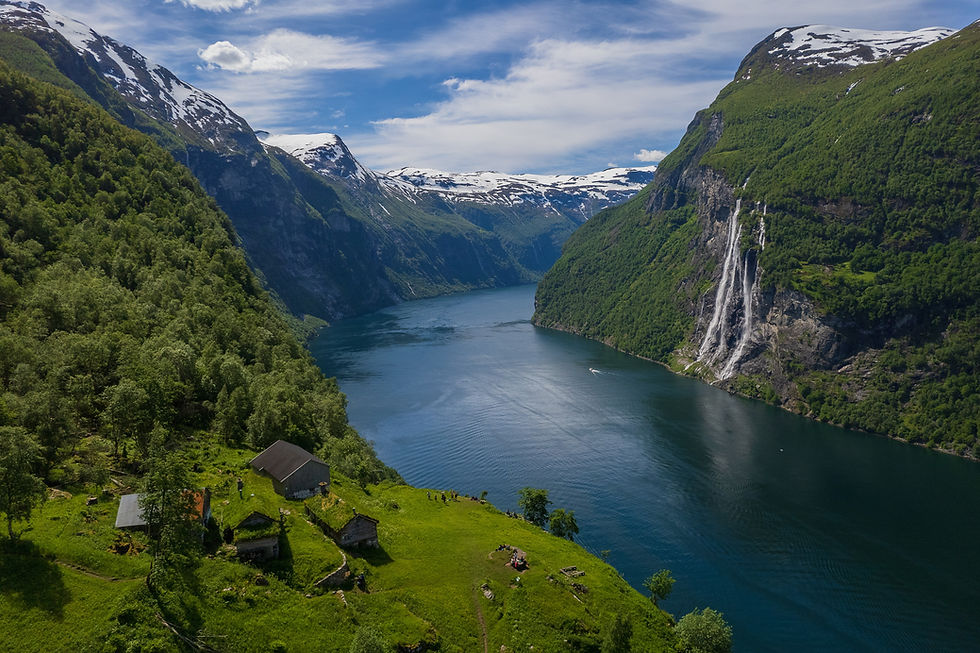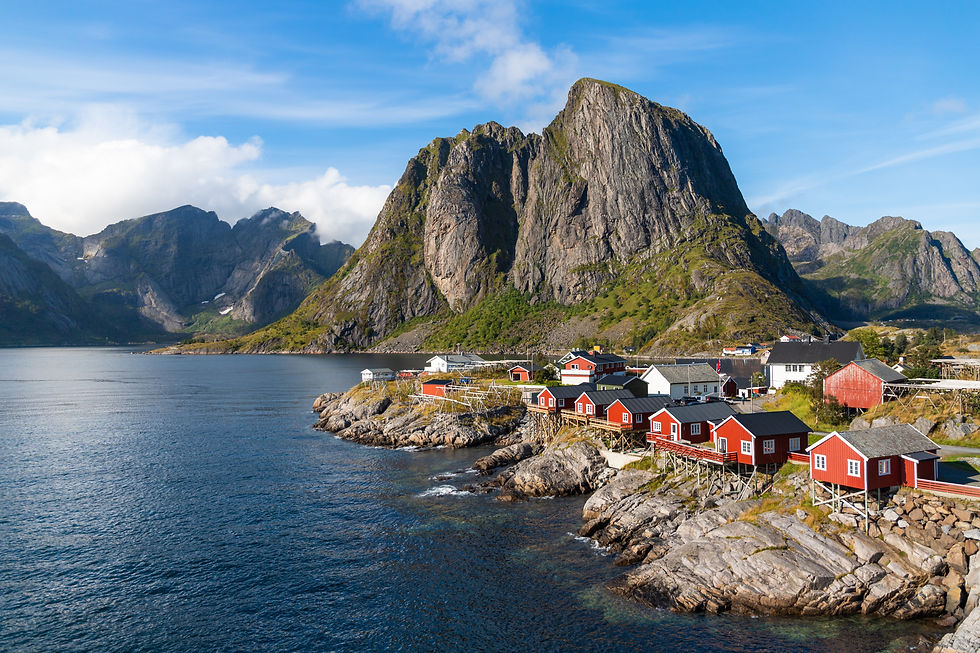Why it is time to travel to Norway, land of Fjords, Glaciers and Midnight Sun
- Adventure Coordinators
- Oct 4
- 7 min read

Some countries have a way of making you feel small in the best possible sense, and Norway is one of them. It is a land of fjords that cut deep into the coast, mountains that rise sharply into the sky, and forests and tundra that seem to stretch forever. Glaciers carve valleys, rivers tumble over cliffs, and in the far north the midnight sun lingers through the summer nights. Norway is at once majestic and welcoming, a place where raw wilderness sits comfortably alongside sleek Scandinavian design, and where history and mythology feel very much alive.
For travellers, it offers a rare mix. You can spend a morning wandering through a world-class gallery in Oslo, take a train that winds across high mountain plateaus, and end your day gazing down from a cliff that feels like the edge of the world. Or you can sail through a fjord where waterfalls tumble from cliffs so high they vanish into the clouds, then return to shore for a dinner of freshly caught salmon or reindeer with lingonberries. Norway invites you to move at your own pace: active days of hiking or skiing balanced by evenings of cultural immersion, or perhaps just sitting still and watching the way light plays across water and rock.
And with southern Europe heating up more and more each summer, it is time to travel to Norway, land of fjords, glaciers and midnight sun
When to Go
Timing your visit is part of the adventure. Summer, from June to August, is the prime season for hiking and cruising the fjords, when the days are long and the landscapes lush and green. Northern Norway straddles the Arctic Circle, which means in June and July you can read a book at midnight in full daylight.
Winter brings its own allure. From January through March, skiing is at its best, whether you prefer downhill slopes or endless cross-country trails winding through forest and tundra. The darker months are also the best time to see the aurora borealis, the Northern Lights that dance across the sky in rippling waves of green and purple.

Oslo: Art, History and Urban Energy
Most journeys begin in Oslo, a city that packs a surprising amount into its compact centre. Here you can spend hours exploring the Munch Museum or the National Gallery, home to Edvard Munch’s The Scream, a painting that seems to capture something essential about the Norwegian psyche. At the Viking Ship Museum, you stand before ninth-century vessels so well preserved it feels almost possible to launch them again. The Fram Museum tells of polar exploration, with the ship Fram encased inside, its wood still smelling faintly of tar and salt.
Oslo is more than museums, though. Its café culture is lively, its restaurants inventive, and its nightlife ranges from high-brow opera to indie rock. A stroll through Vigeland Park, filled with Gustav Vigeland’s playful and sometimes eccentric sculptures, shows another side of Norwegian creativity. Here art spills into the outdoors, just as nature weaves into daily life.

The Journey West: Bergen and Beyond
From Oslo, one of the great railway journeys of Europe, and indeed the world, takes you across the Hardangervidda Plateau to Bergen. The line passes through hand-cut tunnels, past waterfalls that crash down cliffs, and over high mountain moorland where snow lingers well into summer. The most famous stretch is the Flåmsbana, which drops 900 metres in just 20 kilometres, a feat of engineering that never fails to impress.

Bergen itself is irresistible. Surrounded by hills, islands and fjords, it is one of Norway’s most charming cities. The old Hanseatic quarter of Bryggen, with its rows of colourful wooden warehouses, is now a UNESCO World Heritage site. Today those buildings house shops, galleries and restaurants, but walking along their creaking floors it is easy to imagine the days when this was a thriving centre of trade. Bergen also makes an ideal base for exploring nearby fjords or simply enjoying the bustle of a city that feels both historic and modern.

Nature’s Showpieces: Fjords, Glaciers
Norway’s natural wonders are as varied as they are spectacular. Pulpit Rock, or Preikestolen, rises 600 metres above Lysefjord. Standing on its flat top, with nothing but air between you and the fjord far below, is one of those moments where fear and awe combine in equal measure.

Jostedalsbreen, mainland Europe’s largest icecap, sprawls across nearly 500 square kilometres, sending tongues of ice down into valleys where you can hike with a guide. It is a chance to step onto a moving river of ice, to hear the creaks and groans of a glacier alive beneath your feet.
Then there is Sognefjord, the longest fjord in Norway, cutting almost 200 kilometres inland. Its sheer walls rise a kilometre into the sky, dotted with tiny farms that cling to strips of land between mountain and water. Waterfalls plunge down cliffs, catching the sunlight in shifting colours. Around Sognefjord you find many of Norway’s treasures: those glaciers of Jostedalsbreen, the famous Flåm railway, and stave churches that seem to whisper stories from the past.

Beautiful Stave Churches
Urnes Stave Church, set above the Lusterfjord, is Norway’s oldest preserved church, its wooden beams dating back to the 12th century. And not too far away Borgund's stave church is even more impressive. Dedicated to St. Andrew, its dark, simple interior and rustic altar will leave a powerful impression. Outside, the country’s only surviving free-standing medieval wooden bell tower stands like a sentinel. Nearby, Viking-era finds displayed in a small museum tie it all together—faith, tradition, and myth layered one on top of the other.

Giants, waterfalls and Art Nouveau
For sheer wild beauty, Jotunheimen National Park is hard to beat. Its name means “Home of the Giants,” and the landscape lives up to the title. Soaring peaks, deep valleys, glaciers and Norway’s highest waterfalls make it an outdoor playground. Hiking here is demanding but immensely rewarding.
Geirangerfjord is another highlight, its emerald waters lined by vertical cliffs and tumbling waterfalls like the Seven Sisters. Cruising through the fjord is unforgettable, but so too is the drive down Ørnevegen, the Eagle Road, where hairpin bends deliver dizzying views. Nearby lies Trollstigen, “The Troll’s Ladder,” a mountain road that winds in impossible switchbacks past roaring waterfalls. Driving it requires nerve, but the scenery more than compensates.
Ålesund tells a different story. After a fire destroyed much of the town in 1904, it was rebuilt in Jugendstil, or art nouveau. Today it is Scandinavia’s most complete example of the style, with pastel facades, decorative flourishes and whimsical towers. Wandering its streets feels like stepping into a fairytale.

Northward to the Arctic
Travelling north, you will reach Trondheim, Norway’s historic capital. combining small-town charm with cultural vibrancy. Brightly painted warehouses line the Nidelva River, while wide streets and a pedestrian-friendly centre make it easy to explore. At its heart rises Nidaros Cathedral, the world’s northernmost Gothic cathedral and an unmistakable landmark. Cafés and restaurants give the city a lively energy, fishing boats still ply the harbour, and just beyond the outskirts, forests and hills invite exploration.

Further north still, the landscapes become ever more dramatic. The Lofoten Islands rise from the sea in jagged peaks, often described as a dragon’s tail trailing into the Arctic Ocean. Villages of red fishermen’s cabins dot sheltered bays, while the Viking Museum tells of life when Norse seafarers ruled these waters. Days here are easily filled with hiking, whale watching or simply sitting down to a meal of freshly caught cod and wondering if you have stumbled into paradise.
Tromsø, further north still, is known as the cultural capital of the Arctic. With more pubs per capita than anywhere else in Norway, it has a lively social scene. Its setting is equally appealing, ringed by mountains and fjords. In summer, the midnight sun bathes the town in golden light, best viewed from the top of Storsteinen. In winter, Tromsø is one of the best places to see the Northern Lights.

The High Arctic: Svalbard
And then there is Svalbard, Norway’s true Arctic frontier. Lying high in the Arctic Ocean, it is a realm of glaciers, ice and wildlife. Here you might spot polar bears, walrus, Arctic fox and countless seabirds. Cruising among ice floes, the silence broken only by the sound of cracking ice or the splash of a whale, you feel as though you’ve reached the edge of the world.

The Norwegian way of life
Norway is not just about sights—it is about experiences, especially those true Norwegian ones. Hike a mountain trail where waterfalls roar and fjords stretch into the distance. Join a guided glacier walk, crampons crunching on blue ice. Or follow the coastal route by cruise ship, an 11-day voyage that traces the country’s rugged western edge from Bergen to Kirkenes near the Russian border, linking remote communities and showing the coastline at its most beautiful.
In winter, strap on skis and explore endless trails. Cross-country skiing here is not just a sport but a way of life, a tradition woven into the Norwegian spirit.
And don't forget to enjoy a meal: perhaps cod with potatoes, reindeer steak with gravy and lingonberries, or salmon pulled fresh from icy waters.

Why Norway?
What makes Norway so compelling is the way its landscapes and culture intertwine. Nature is never far away, even in the heart of its cities. History feels tangible in stave churches, Viking artefacts and fishing villages that have endured for centuries. Modern life thrives too, with lively nightlife, innovative architecture and a flair for design.
For me, the most lasting memory is not just one scene but the contrasts—the moment of silence on a glacier, followed by the bustle of a Bergen café; the golden glow of the midnight sun on the ancient beams of a stave church and the glassy modernity of an Oslo gallery.
Norway has a way of reminding you that the world is vast and varied, that beauty exists in many forms, and that travel is not about ticking boxes but about experiencing those moments that make you stop, breathe, and feel very much alive.
Did I pique your interest? Contact me to start planning your Norwegian adventure.




Comments